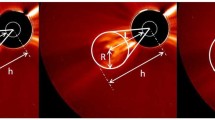Abstract
The formation of the gas giant planets Jupiter and Saturn probably required the growth of massive ∼ 15 Earth-mass cores on a time scale shorter than the ∼ 107 time scale for removal of nebular gas. Relatively minor variations in nebular parameters could preclude the growth of full-size gas giants even in systems in which the terrestrial planet region is similar to our own. Systems containing “failed Jupiters,” resembling Uranus and Neptune in their failure to capture much nebular gas, would be expected to contain more densely populated cometary source regions. They will also eject a smaller number of comets into interstellar space. If systems of this kind were the norm, observation of hyperbolic comets would be unexpected. Monte Carlo calculations of the orbital evolution of region of such systems (the Kuiper belt) indicate that throughout Earth history the cometary impact flux in their terrestrial planet regions would be ∼ 1000 times greater than in our Solar System. It may be speculated that this could frustrate the evolution of organisms that observe and seek to understand their planetary system. For this reason our observation of these planets in our Solar System may tell us nothing about the probability of similar gas giants occurring in other planetary systems. This situation can be corrected by observation of an unbiased sample of planetary systems.
Similar content being viewed by others
References
Arnold, J.R.: 1965,Astrophys. J.,141, 1536–1556.
Barrow, J.D.: 1988,The Anthropic Cosmological Principle, Oxford University Press.
Chamberlin, T.C.: 1905,Fundamental problems of geology, Carnegie Institution of Washington, Year Book #3 for 1904, 195–234.
Duncan, M., Quinn, T. and Tremaine, S: 1987,Astron. J.,94, 1330–1338.
Duncan, M., Quinn, T. and Tremaine, S.: 1988,Astrophys. J.,328, L69-L73.
Fernandez, J.A. and Ip, W.-H.: 1983,Icarus,54, 377–387.
Fernandez, J.A. and Ip, W.-H.: 1984,Icarus,58, 109–120.
Hayashi, C., Nakazawa, K. and Adachi, I.: 1977,Publ. Astron. Soc. Japan,29, 163–196.
Laskar, J., Joutel, F. and Robutel, P.: 1992, The moon: a climate regulator for the Earth, submitted toNature.
Levison, H.F. and Duncan, M.J.: 1992, The gravitational sculpting of the Kuiper belt, in press,Astrophys. J. Letters.
Lissauer, J.J.: 1987,Icarus,69, 249–265.
Lissauer, J.J., Pollack, J.B., Wetherill, G.W. and Stevenson, D.J.: 1993, submitted toNeptune, D. Cruikshank, ed., University of Arizona Press, Tucson.
McGlynn, T.A. and Chapman, R.D.: 1989,Astrophys. J.,346, L105.
Öpik, E.J.: 1951,Proc. Roy. Irish Acad.,54A, 165–199.
Safronov, V.S.: 1969,Evolution of protoplanetary cloud and formation of the Earth and planets, Nauka, Moscow (Translated 1992, NASA TT F-677).
Shoemaker, E.M. and Shoemaker, C.S.: 1993,Program of Conference on Hazards due to Comets and Asteroids, Univ. of Arizona Press, Tucson.
Stern, S.A.: 1990,Proc. Astron. Soc. Pap.,102, 793–795.
Weidenschilling, S.J.: 1977,Astrophys. Space Sci.,51, 153–158.
Wetherill, G.W.: 1975,Proc. Lunar Sci. Conf. 6th, , 1539–1559.
Wetherill, G.W.: 1989,Meteorites,24, 15–22.
Wetherill, G.W.: 1990a,Ann. Rev. Earth Planet Sci.,18, 205–256.
Wetherill, G.W.: 1990b, in: R.L. Newburn, J. Rahe and M. Neugebauer (eds.),Comets in the Post-Halley Era, I.A.U. Coll. 116, Kluwer Acad. Publ., Dordrecht, 537–556.
Wetherill, G.W.: 1991,Science,253, 535–538.
Wetherill, G.W.: 1992,Icarus,100, 307–325.
Weissman, P.R.: 1982,Terrestrial impact rates for long- and short-period comets, Geological Implications of Impacts of Large Asteroids and Comets on the Earth, L.T. Silver and P.H. Schultz, eds., 15–24,Geol. Soc. Am. Special Paper 190.
Weissman, P.R: 1990, V.L. Sharpton and P.D. Ward (eds.),The cometary impactor flux at the Earth: Global Catastrophes in Earth History, Geol. Soc. Am. Special Paper 247, pp. 171–180.
Weissman, P.R.: 1990,Nature,344, 825–830.
Author information
Authors and Affiliations
Rights and permissions
About this article
Cite this article
Wetherill, G.W. Possible consequences of absence of “jupiters” in planetary systems. Astrophys Space Sci 212, 23–32 (1994). https://doi.org/10.1007/BF00984505
Issue Date:
DOI: https://doi.org/10.1007/BF00984505




